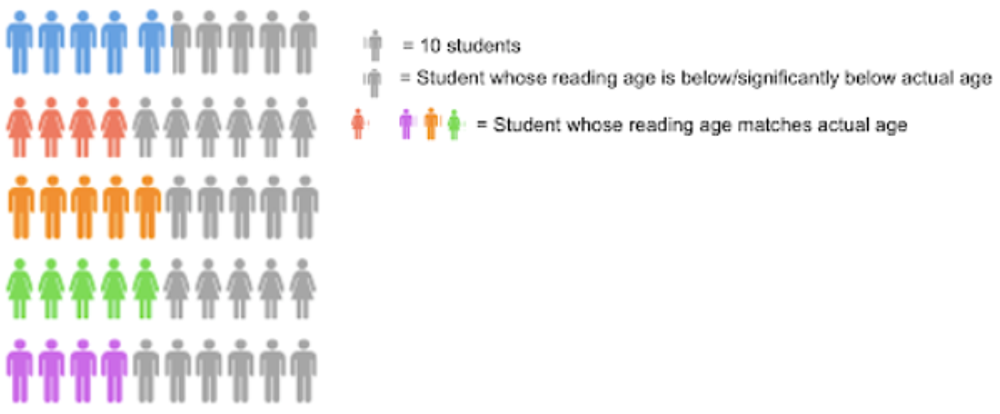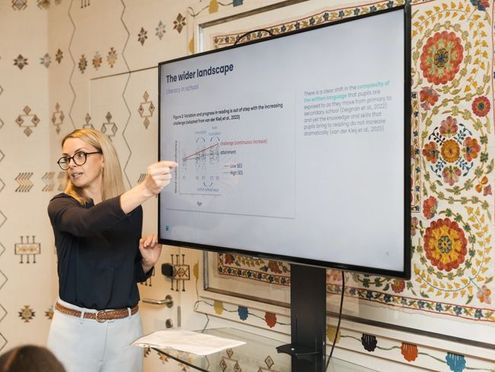Literacy CPD tips to improve whole-school impact
Ensure your staff remember more from your literacy CPD than what was on the lunch menu - follow our top tips for impactful inset.
Every teacher knows that strong literacy is crucial to a student’s academic success; Geoff Barton states in the 2018 Oxford Language Report that “vocabulary is a huge predictor of how far children from any background will succeed at school and beyond.” The knowledge of vocabulary leads to better comprehension, helping students to better understand a topic as a whole. However, how do we extend the benefits of vocabulary T&L to all subjects across the curriculum? Does each member of your faculty know how to harness techniques of disciplinary literacy to see results in their subject, whatever that subject may be? That is why we have compiled a list of tips for improving whole-school literacy CPD, helping you coordinate your vocabulary T&L across the entire curriculum.
Why whole-school literacy CPD?
Traditionally, one might think that a lack of vocabulary knowledge would affect a student primarily in English. However, a lack of ability and confidence in reading comprehension has negative effects on a student’s progress in every subject. The average reading age of a GCSE paper is 15 years and 7 months – a reading age lower than this leaves students unable to access their examinations for every subject, not just English. According to the Read All About It report, up to 20% of GCSE students have a reading age of 11 or under.
Take this example question:

Imagine if a learner did not know what the word “constant” meant. They may struggle with this question, not knowing what steps to take to solve it, despite having the mathematical skills to answer it correctly. This leaves the teacher unsure as to what exactly learners are struggling with (and leaves the student unable to grasp already difficult concepts due to a lack of Tier 2 vocabulary.)
Take this example from a Biology paper:

Not only is Science already full of subject-specific Tier 3 vocabulary, but there is also the confounding factor of Tier 2 vocabulary within the question. Again, imagine a learner did not know the word “adjust” – a teacher may struggle to know which part of the question the student did not understand.
Whole-school literacy CPD assists teachers in highlighting subject-specific vocabulary in their curriculum, increasing students’ comprehension of Tier 3 key words. This aids teachers’ awareness of their class’s learning, saving them time!
How to encourage teachers to buy in to literacy CPD
Returning to Geoff Barton, he states that “we should see reading, writing, vocabulary, speaking, listening, debate, and more, as the complex tapestry of great teaching, enacted in every lesson, in every phase and subject domain, by every teacher.”
A busy teacher likely doesn’t have the time or energy to retain information on a topic, such as whole-school literacy, that doesn’t feel like it directly relates to their subject. Some teachers may struggle to see the importance of focusing on literacy in Maths, or Chemistry, or Computer Science. However, research by the Educational Endowment Foundation suggests that teachers in every subject need a focus on literacy, helping students to access learning across the curriculum.
It’s crucial to base in evidence (such as the examples given above) the importance of teaching Tier 2 and Tier 3 vocabulary in all subjects across school, using examples of reading reports such as the Oxford Language Report, the Read All About It report and others. According to these reports, 50% of GCSE-age students have the sufficient reading age to access their GCSE papers – these sorts of results are important when trying to implement whole-school literacy.

Using the infographic given above as inspiration, you could analyse the data for your school and create a context-specific infographic for your staff, impressing upon them the importance of a literacy focus in every subject.
What does this gap look like in your school? Just how many students are ill-equipped to access their own learning? This statistic matters for outcomes in every subject, and this should be impressed upon your entire faculty to improve buy-in for your whole-school literacy CPD.
Strategies to teach Tier 2 vocabulary
You have the research and the enthusiasm to improve literacy across your whole school, but where should you get started? Here are some tips as to how you can encourage the improvement of your students’ Tier 2 vocabulary in every classroom throughout your school.
Have meaningful conversations with learners
Tier 2 words aren’t as commonly used in conversation as Tier 1 words, so an easy, not too time-consuming way of improving vocabulary across your school is by encouraging teachers to use Tier 2 language in their conversations with learners. This simple switch allows learners to see high-level, specialised language embedded into conversation. Instead of “how should this slide be changed”, use adjust. Instead of “watch and see what happens”, use monitor. Knowing these words will be helpful for your learners in every subject.
Combine reading, writing and oracy
Encourage your colleagues to rework the way learners make note of new keywords and vocabulary. Instead of having learners copy definitions from the board, try to put new language in context, promoting deeper comprehension.
Reward the use of ambitious vocabulary in writing and conversation. Come exam time, your learners will have a deeper understanding of the language in their papers, leading to better results.
Bedrock Vocabulary utilises the benefits of this type of learning, rewarding learners for crafting their own vocabulary definitions in their topic lessons.
Use root words
Teaching learners how to break down words into their roots and affixes helps them not only to understand the words currently being taught, but also how to break down words they may potentially encounter in the future - for example, breaking transform down into its roots (‘trans’ meaning across, and ‘formare’ meaning form, so moving across forms).
If this understanding of words is taught consistently across the curriculum, knowledge from one subject will be transferred to another, benefitting your whole faculty. When every member of staff contributes to improving learners' literacy, the benefits are seen across the curriculum.
Strategies to teach Tier 3 vocabulary
Teachers in STEM subjects may be more accustomed to teaching Tier 3 terminology. In fact, you probably teach it every day. However, could the way you teach your subject-specific vocabulary be improved? Are you promoting Tier 3 vocabulary development in every subject across the curriculum? If so, are there ways the process could be streamlined to save your faculty time?
Put new Tier 3 vocabulary into context
Going from hearing a term for the first time to using it accurately doesn’t happen immediately. To speed up the process, use new keywords in sentences, link them to pictures and put them into a cultural context. Words like equator might be difficult to understand fully without a picture or video; these can be amazing ways to dual code learners’ understanding.
Reward learners for using new Tier 3 vocabulary correctly, and actively upgrade learners' words as you converse. If a word they use could be replaced with a more specialised topic or keyword, suggest it. Model its use.
The time spent linking these words to contexts learners can understand saves time reteaching them later, and earns marks in important exams.
Make visual Tier 3 vocabuary displays
Like Tier 2 vocabulary, Tier 3 terminology benefits greatly from being broken down into roots and affixes. For example, words like “photosynthesis” become much easier to understand when learners know photo means “light”, and synthesis means “to put together”.
Breaking these words down in a physical display not only reinforces understanding of subject-specific terminology, but also helps learners apply their understanding of roots and affixes to other subjects, strengthening your school’s disciplinary literacy.
Create a bespoke Tier 3 vocabulary curriculum
The absolute best way to ensure you are consistently teaching Tier 3 vocabulary, in every subject, is to build a bespoke curriculum. However, while this has great return on interest over time, crafting a whole-school literacy curriculum from the ground up is a time-consuming process - you may be worrying about staff buy-in at the prospect of such a large task.
Luckily, our EdTech solution Bedrock Mapper is designed to make this process easier, providing teachers with pre-made, Bedrock verified content and curricula to scaffold your Tier 3 vocabulary curriculum. Mapper is a time-saving solution to allow your school to create a subject-specific, consistent vocabulary curriculum (and reap the benefits!)




